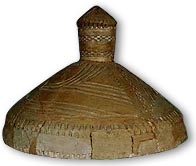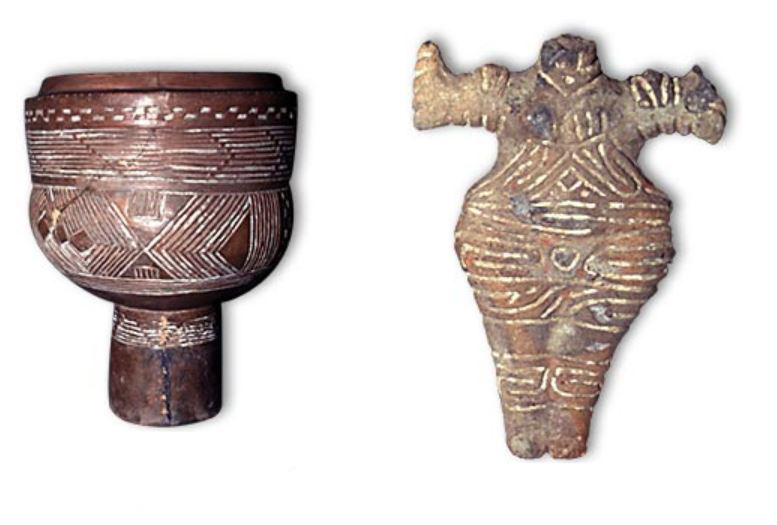- Home
- Time and place
- From the Neolithic to The Chalcolithic in Dobrogea
- Boian Culture
Black polished vase, decorated raised geometrical design in white clay.
Lid with excized geometrical decoration, still showing incrustations of white clay (origin : Tangâru).
Site Eponym : Located on an island on Lake Boian in the south of Romanian province of Muntenia, north of the Danube.
Dates : Middle to recent Neolithic culture, partially contemporary of the Hamangia culture and divided into four steps; the last, called "the Spantov period" dates from the first half of the fifth millennium BC.
Geographic Setting : Their geographical region (Muntenia) is rather restricted during their primitive phase, then a rather extensive territory, notably toward the Black Sea, until it displaced the Hamangia in Dobrogea. The Boian culture is referred to as the Marita in Bulgaria.
Habitation : At first modest dwellings situated on the river ledges and in the valley. During the stages which followed, we see successive occupations of the same region, dwellings successively more structured and sometimes fortified, and next, the birth of the tells very frequently reoccupied by the Gumelnita population.
Material Means : Ceramics abundantly decorated with carved of raised geometric motifs with an inlay of white clay; some tiny copper objects in the late period.
Funeral Rites : Most commonly buried in a curled-up position.
Cup with stand, richly decorated in geometric patterns, raised white clay, characteristic of the Boian culture (origin : Vidra, Giurgiu, Romania).
Terra cotta figurine of the Boian culture (origin : Radovanu).
The Boian culture is found in the Romanian territory in Valachia up to the Jui Valley, in Dobrogea, to Moldavia in the southwest and to Transylvania in the southeast. Through out the four periods of its evolution, the culture spread southward down to the banks of the Aegean Sea. In the Bulgaria it is known by the name Marica.
The settlements are set up on high terraces or on headlands and sometimes show signs of fortification (defensive ditches). During the early two periods the dwellings were buried in the ground and quickly became rectangular homes of wood framing and cob (straw and clay), built at ground level.
The economy is characterized by the practice of agriculture, animal husbandry, hunting, gathering and fishing.
At the beginning of their evolution, lithic tools are indicated by the presence of microliths, next to which various types of cut flint and polished stone tools appear. The ceramic, especially ones of great quality are charcoal gray or black, polished and carved, extrusions or grooved and with incrustations of white clay.
The decorations are principally geometrical. Towards the end of its evolution, this culture seems to have developed copper metallurgy.
The tribes of the Boian culture practiced burial and funerary rites and rituals, which varied over the course of time.
Because of its characteristics, the Boian culture is attributed to the recent Neolithic era where it belongs to the cultural category Boian-Gumelnita.


